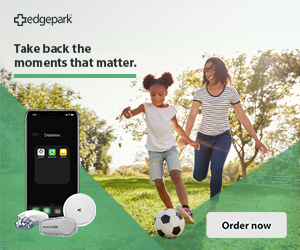What to expect during a telehealth appointment vs. an in-office visit with your doctor
Thanks to today's technology, setting a telehealth diabetes appointment with your doctor has never been easier. With just the touch of a button (or two), you can log into a secure program on your computer or application on your smartphone for a face-to-face telehealth visit. This technology has been around for some time, but due to the emergence of COVID-19, many more people have begun to seeking medical attention remotely, from the safety of their homes.
If you're living with type 1 diabetes (t1d), you know that monitoring blood sugar, counting carbs and managing insulin are key to maintaining good health. Telehealth appointments are a convenient way to frequently connect with your doctor from a safe distance, which can positively affect your well-being and day-to-day diabetes management.
By knowing the differences and similarities between an in-office session and a telehealth appointment, you will be able to prepare health readings, identify concerns and ask questions, helping to make your first telehealth visit a success.
What you should know about telehealth diabetes care
Telehealth health sessions leverage conferencing software on a computer or smartphone to initiate a conversation between you and your doctor. You attend the appointment from the location of your choice — there's no driving to the doctor's office.
These telehealth meetings occur through a patient portal or other secure program. If your doctor's office uses a smartphone app, download the app prior to the appointment. Log in and test the app to minimize any potential technical issues. It's a good idea to double-check with your insurance company to confirm that telehealth diabetes care is reimbursed by your plan, and to request the amount of the copay. Additionally, if you feel you are experiencing symptoms of COVID-19, check to see if your plan covers testing and related treatment.
Registration through the online medical portal of your doctor's office is necessary to participate in a telehealth visit. Using the portal facilitates communication between you and the medical staff. For example, you can use it to confirm an appointment, ask a question about a previous session or respond to a question.
Medical guidelines recommend that patients with t1d establish ongoing care by attending appointments every three to four months. Through regular communication with medical care staff, telehealth visits can help patients better control their diabetes. Doctors can provide timely recommendations to help manage blood sugar readings, A1C targets and health complications.
Similar but different
In-office sessions and telehealth diabetes appointments have a few similar processes. For instance, when you attend an office visit, you typically check in at the front desk and fill out paperwork that covers consent, medical history and concerns you want to address during the visit. The reception staff then accepts your copay. For a virtual visit, you check in via the online portal. It will prompt you to make a copay, update your medical history, confirm medications and document health concerns.
The routine to review your diabetes and health measures is also similar. At the office, the doctor will typically review your blood glucose log on paper or through a data-sharing program or app if you use a continuous glucose monitor (CGM). Then, they will usually check your weight, blood pressure, temperature, pulse, oxygen level, blood sugar level, A1C and urine.
During telehealth appointments, you provide your doctor with these health readings. If you have remote patient monitoring equipment at home, like a blood pressure monitor, scale, CGM and thermometer, you can record these readings prior to the appointment. If a urine test is a regular part of the routine, make sure to order the at-home urine test strips requested by your doctor.
Similar to preparing for an in-office visit, it helps to create a list of questions and concerns you want to review during the appointment. Completing these steps ahead of time can allow for a stress-free visit.
Tips for attending telehealth appointments
If this is your first telehealth care visit, you may run into some technical glitches. It happens! In this case, it's wise to have a back-up plan for the doctor to call you directly if the computer software or mobile app does not work.
When attending the virtual meeting, remember that your doctor is experienced. No information that you provide or question you ask will be shocking. Ask all questions — even those you feel are embarrassing. Effective communication improves the doctor-patient relationship.
Here is a short list of tips for ensuring your telehealth meetings with physicians are successful:
- Be honest with your doctor. If you haven't been taking your medications, exercising or following other recommendations, don't hesitate to say so. Medical professionals need a clear picture of your health to provide the best care possible.
- Ask questions about insulin and report concerns about high or low blood sugar readings.
- Discuss self-care, your diet, physical activity, sleep and other habits. Be sure to ask for help if you are struggling.
- Make a list of all current medications and supplements for discussion. This is important because over-the-counter supplements may counteract or interact negatively with prescribed medications.
- Ask for refills. Take inventory of your medications and supplies so the doctor can send prescriptions to the pharmacy.
- Mention skin concerns, and upload a photo of any irritated areas before the appointment.
- Let the doctor know if you are experiencing vision or dental issues.
- If you are having trouble managing your diet or are feeling depressed, let the doctor know so they can make a referral for additional care services.
With all appointments — in-office or telehealth — it's crucial to be as specific as possible about your health concerns. Tell your doctor when the condition began, if the issue is constant or whether it comes and goes. Report the duration and frequency, the time of day it's most likely to flare up and what makes the condition better or worse. Have photos available to upload when needed. No detail is too small to arrive at an accurate diagnosis!
You may find that you enjoy attending telehealth diabetes appointments because you have the doctor's undivided attention (and can save time by not driving to their office). Following up with questions through the online medical portal will ensure that you receive answers in a timely manner instead of having to wait until the next appointment, helping you live an active, full life.
Looking to prepare for your next telehealth appointment? You can find diabetes self-care supplies and remote monitoring equipment on the Edgepark website.




